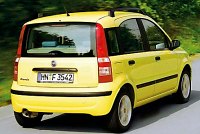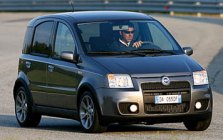|
FIAT Panda Mk2
Debut: 2003
Maker: FIAT
Predecessor: No
|
|
 The
Giugiaro-designed original Panda (1980-2002) was a great success. Even
though it was a small range offered with limited choices of engines and
options, its honest personality and practical functions earned it 4.6
million
units of sales. But this car has no relationship at all with the Panda
we are going to talk about. The new Panda is not only not a direct
successor
to the old one, but it would have been named "Gingo" if Renault didn’t
slam it for pronouncing too close to Twingo. In the end, Fiat decided
to
rename it to Panda. The
Giugiaro-designed original Panda (1980-2002) was a great success. Even
though it was a small range offered with limited choices of engines and
options, its honest personality and practical functions earned it 4.6
million
units of sales. But this car has no relationship at all with the Panda
we are going to talk about. The new Panda is not only not a direct
successor
to the old one, but it would have been named "Gingo" if Renault didn’t
slam it for pronouncing too close to Twingo. In the end, Fiat decided
to
rename it to Panda.
The
new Panda
falls into
the "sub-mini" segment consists of many Japanese K-cars, Volkswagen
Lupo,
Renault Twingo, Hyundai Atoz, Daewoo Matiz and the like. Measuring 3.54
meters in length, it is 33cm shorter than its bigger sister Punto but
22cm
longer than baby Seicento. While its 2.30 meters wheelbase is shorter
than
most K-cars (who can beat them in space efficiency?), its 1.54m height
is simply MPV-like. People sit high in the cabin, enjoying excellent
visibility
through huge windows over the low waistlines. The bright and airy cabin
has plenty of headroom and decent legroom to fulfill the task as a city
car. Wide-opening doors aid easy access. The one-piece plastic
dashboard
is dominated by a big center console on which gear lever is mounted.
The
latter makes gearshift more relaxing. In terms of materials, it doesn’t
set any new standard, but with some soft-touch plastic and decent cloth
trim, it feels far better made than Korean mini cars.
 Now
you start understanding its design philosophy: this is a no-frill car.
Functions and practicality are put in first place. The same goes for
exterior
styling. Here, I must admit my disappointment that it lost the charming
style of traditional small Fiat, say, Uno, the old Panda and Punto Mk1.
Like the recently facelifted Punto, the new Panda proves that Fiat’s
studio
needs to be revitalized. It seems that since the 4-line logo was
replaced
by the circular badge, Fiat’s fortune as well as creativity has been
falling.
The square, bland and featureless design of Panda is so conservative
that
even Volkswagen would not adopt. Now
you start understanding its design philosophy: this is a no-frill car.
Functions and practicality are put in first place. The same goes for
exterior
styling. Here, I must admit my disappointment that it lost the charming
style of traditional small Fiat, say, Uno, the old Panda and Punto Mk1.
Like the recently facelifted Punto, the new Panda proves that Fiat’s
studio
needs to be revitalized. It seems that since the 4-line logo was
replaced
by the circular badge, Fiat’s fortune as well as creativity has been
falling.
The square, bland and featureless design of Panda is so conservative
that
even Volkswagen would not adopt.
However,
the new
Panda is
a much better car to drive than to look at. Its chassis is unusually
mature
for the class. This means high rigidity, absorbent and quiet ride (even
on bad surfaces) and excellent noise insulation. Its FIRE engines are
sweet.
Although the 54hp 1.1-litre and 60hp 1.2-litre still employ 2 valves
per
cylinder, they are torquey and never noisy. The 60hp engine is
especially
lovely, giving the not-so-lightweight Panda a competitive acceleration
(0-60mph in about 13 seconds), while 75 lbft of torque is useful for
overtaking.
 However,
the best of the bunch is the new 1.3-litre common-rail turbo diesel.
It’s
the world’s most compact diesel engine. Sophisticated multi-jet
common-rail
direct injection enables it to produce a respectable 70 horsepower and
133 lbft of torque yet returning 66mpg of fuel consumption. And
unusually,
the diesel engine tops the Panda range as the fastest and most
expensive
model. However,
the best of the bunch is the new 1.3-litre common-rail turbo diesel.
It’s
the world’s most compact diesel engine. Sophisticated multi-jet
common-rail
direct injection enables it to produce a respectable 70 horsepower and
133 lbft of torque yet returning 66mpg of fuel consumption. And
unusually,
the diesel engine tops the Panda range as the fastest and most
expensive
model.
In
driver’s point
of view,
the new Panda is also fun to drive. Although the skinny tires lack the
necessary grip to exploit its potential or to test its suspicious body
control, its handling is agile and predictable, while steering is sharp
and direct.
Whether
it will
succeed is
difficult to predict. That will depend on how well people accept its
conservative
styling. Our first choice is still Daihatsu Mira, as it is a little
faster,
a little more spacious, a little better built and a little prettier
than
the Panda, if not as refined. Anyway, the Panda proves that Fiat is
still
capable of making good small cars. We wish it could help the Italian
giant
overcoming its darkest days. |
| The
above report was last updated on 26 Sep
2003. All Rights Reserved. |
Panda 100HP
|
 A
supermini won't be a complete range without a hot hatch model. After 3
years, Fiat Panda is finally offering us its hot hatch version, Panda
100HP. Outside, this car looks really cool, thanks to the new bumper
with huge intakes, the extra skirts, the obviously lowered ride height
(yes, it is 25mm lower than the regular Panda), the widened fenders
which push all four wheels outside to enhance cornering stability, and
the eye-catching 15-inch alloy wheels wrapping with 195/45 rubbers. Its
sporting intention is apparent. A
supermini won't be a complete range without a hot hatch model. After 3
years, Fiat Panda is finally offering us its hot hatch version, Panda
100HP. Outside, this car looks really cool, thanks to the new bumper
with huge intakes, the extra skirts, the obviously lowered ride height
(yes, it is 25mm lower than the regular Panda), the widened fenders
which push all four wheels outside to enhance cornering stability, and
the eye-catching 15-inch alloy wheels wrapping with 195/45 rubbers. Its
sporting intention is apparent.
Underneath the clothes you will find a superb engine: Fiat's new 1368cc
twin-cam 16-valve engine with variable valve timing and
port-deactivation. It produces 100 horsepower, hence giving the name of
this car, and 97 lb-ft of torque - both slightly more than those
offered in Grande Punto. However, what really matters is not numbers,
but its real-world behaviour: it has sharp throttle response
(especially if you press the Sport mode button), it has even spread of
torque across a wide band, and most important, it is smooth and eager.
It loves to rev towards 7000 rpm limit, something no one else in this
segment can match. It reminds us Fiat used to build the world's best
twin-cam four-cylinder engines in the 60s and 70s.
Delivering as much joy is the new 6-speed manual transmission. Slick
gearshifts combined with well-chosen ratios means the gearbox works
flawlessly with the sweet engine. In this way, the Panda 100HP always
feels more satisfying to drive than its average performance suggests
(115mph top speed, 0-60mph in 8.9 seconds).
 In the
handling side, this car also exceeds our expectation. It grips well,
balances well and corners stable. Any worry about cornering stability
from the tall body is washed away by the 25 percent increase in spring
rate and the 25mm lower ride height. Brilliantly, the conversion did
not sacrifice much of the supple ride associated with the regular
Panda. The reason? Fiat has replaced the rubber bump stops with items
made of Cellasto polymer. Besides, the rigid chassis also helps to
absorb vibration and harshness. The lifeless electric power steering is
also improved by the Sport mode button, which weighs up steering effort
while sharpening throttle response. The bigger brakes, come from Grande
Punto, are more than capable to do the job. In the
handling side, this car also exceeds our expectation. It grips well,
balances well and corners stable. Any worry about cornering stability
from the tall body is washed away by the 25 percent increase in spring
rate and the 25mm lower ride height. Brilliantly, the conversion did
not sacrifice much of the supple ride associated with the regular
Panda. The reason? Fiat has replaced the rubber bump stops with items
made of Cellasto polymer. Besides, the rigid chassis also helps to
absorb vibration and harshness. The lifeless electric power steering is
also improved by the Sport mode button, which weighs up steering effort
while sharpening throttle response. The bigger brakes, come from Grande
Punto, are more than capable to do the job.
Overall, the Panda 100HP feels agile and energetic through corners.
Quick it may not be, it guarantees a great deal of driving fun from
just £10,000 (UK price) while cost little to run (fuel
consumption is 43.5mpg for combined cycle). Fiat is finally back to
form. |
| The
above report was last updated on 6 Dec 2006. All
Rights Reserved. |
|
|